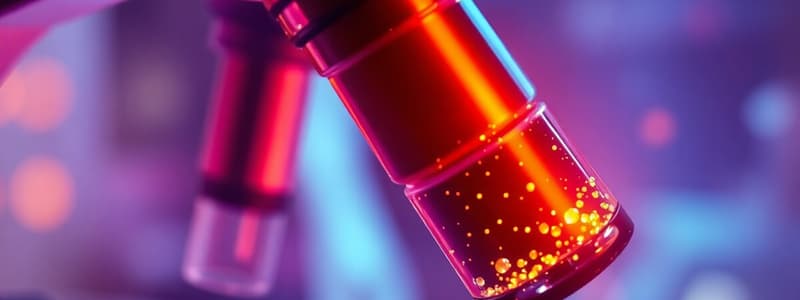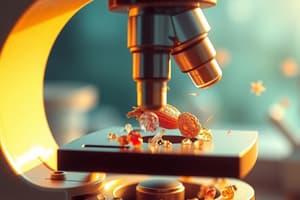Podcast
Questions and Answers
Match the following types of microscopes with their characteristics:
Match the following types of microscopes with their characteristics:
Light microscope = Ideal for viewing live specimens Electron microscope = Provides higher magnification and resolution
Match the following key terms related to microscopes:
Match the following key terms related to microscopes:
Magnification = Enlarges the appearance of an object Resolution = Ability to distinguish between two close objects Light microscope = Lower resolution than electron microscopes Electron microscope = Shows images in black and white
Match the following microscope features with their descriptions:
Match the following microscope features with their descriptions:
Fine focus = Used for precise focusing Coarse focus = Used for initial focusing Eyepiece lens = Contains a magnification of 10x Diaphragm = Regulates the amount of light entering the microscope
Match the following statements with the appropriate microscope type:
Match the following statements with the appropriate microscope type:
Match the following components of light microscopes with their functions:
Match the following components of light microscopes with their functions:
Match the following types of specimens that can be viewed under microscopes:
Match the following types of specimens that can be viewed under microscopes:
Match the following terms with their related aspects of microscopy:
Match the following terms with their related aspects of microscopy:
Match the following magnification calculations with their respective descriptions:
Match the following magnification calculations with their respective descriptions:
Flashcards are hidden until you start studying
Study Notes
What is a Microscope?
- A scientific instrument that allows the observation of objects too small to be seen by the naked eye.
Types of Microscopes
- Light Microscopes (Optical Microscopes)
- Uses visible light to create magnified images
- Electron Microscopes
- Uses a beam of electrons as a source of illumination
Key Words
- Magnification: Enlarges the appearance of an object, making it look bigger.
- Resolution: The ability of a microscope to distinguish between two closely spaced objects as separate.
Light Microscopes
- Ideal for viewing live cells and tissues and large cellular structures like the nucleus or chloroplast.
- Easy to use, can view live specimens, and is inexpensive.
- Has lower magnification and resolution compared to electron microscopes.
- Cannot view smaller organelles like ribosomes or membrane structures.
Electron Microscopes
- Much higher magnification and resolution compared to light microscopes.
- Cannot view live specimens, requires expertise to operate, and is expensive.
Differences Between Light and Electron Microscopes
- Electron microscopes are much more expensive than light microscopes.
- Light microscopes can display color, while electron microscopes only show black and white.
- Specimens must be dead for viewing with an electron microscope, while they can be alive or dead for light microscopy
- Electron microscopes have greater resolution
- Electron microscopes have greater magnification
Parts of a Light Microscope
- Fine focus
- Base
- Diaphragm
- High power objective lens
- Low and medium power objective lenses
- Stage clips
- Coarse focus
- Stage
- Eyepiece lens (10x)
- Arm
- Light source
Calculating Magnification
- Used to determine the magnification of an object.
- The formula for magnification is: Magnification = Magnification of eyepiece lens x Magnification of objective lens
Studying That Suits You
Use AI to generate personalized quizzes and flashcards to suit your learning preferences.




